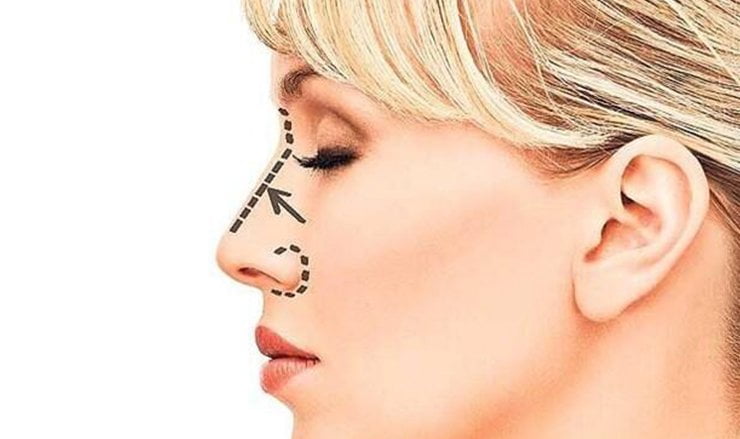Nose surgery (rhinoplasty) improves the appearance and proportion of your nose, enhancing facial balance. Rhinoplasty can also correct impaired breathing caused by structural abnormalities.
Who is a candidate?
People with:
- An abnormal appearance of the nose as a result of birth defects, injury, or disease.
- A nose that is cosmetically unattractive or does not “fit” with other facial features.
Rhinoplasty enhances facial harmony and the proportions of your nose. It can also correct impaired breathing caused by structural defects in the nose.
You may be a good candidate for rhinoplasty if:
- Your facial growth is complete (you should be over at least 18th years old)
- You are physically healthy
You don’t smoke, - You have a positive outlook and realistic goals in mind for the improvement of your appearance.
Nose Job can change:
Nose size in relation to facial balance
Nose width at the bridge or in the size and position of the nostrils
Nose profile with visible humps or depressions on the bridge
Nasal tip that is enlarged or bulbous, drooping, upturned or hooked
Nostrils that are large, wide, or upturned
Nasal asymmetry
If you desire a more symmetrical nose, keep in mind that everyone’s face is asymmetric to some degree. Results may not be completely symmetric, although the goal is to create facial balance and correct proportion.
During the planning the following will be discussed with the candidate:
- ethnic characteristics,
- age and
- whether your skin is thick or thin, oily or dry.
It is essential that the candidate have a mature personality and that the nose be fully developed, which happens around 17-18 years of age. We also may recommend additional procedures like chin enhancement to achieve a better overall facial appearance and face profile.
Rhinoplasty to correct a deviated septum:
Nose surgery that’s done to improve an obstructed airway requires careful evaluation of the nasal structure as it relates to airflow and breathing.
Correction of a deviated septum, one of the most common causes of breathing impairment, is achieved by adjusting the nasal structure to produce better alignment.

Your consultatıon for rhinoplasty :
It would be better to discuss all your questions in your mind regarding rhinoplasty and during your rhinoplasty consultation be prepared to discuss:
- What is your surgical goals with regard to both appearance and breathing?
What is your medical conditions i.e. drug allergies, and previous medical treatments?
Are you currently taking any medications i.e. vitamins, herbal supplements, alcohol, tobacco, and drug use
Have you undergone any previous surgeries of nose or nearby structures?
We might like to discuss the following during this consultation ?
Evaluate your general health status and any pre-existing health conditions or risk factors
The options available to you for nose reshaping
Examine and measure your face
Take photographs
Discuss your nose surgery options
Recommend a course of treatment
Discuss likely outcomes of a nose surgery and any risks or potential complications
It’s very important to understand all aspects of your rhinoplasty procedure. It’s natural to feel some anxiety, whether it’s excitement for your anticipated new look or a bit of preoperative stress. Don’t be shy about discussing these feelings with your plastic surgeon.
Just before your rhinoplasty surgery, you may be asked to:
Get a blood test
Take certain medications or adjust your current medications such as thyroid pills
Stop smoking and
Avoid taking certain medicines such as aspirin and herbal supplements as they can increase bleeding.
Result
A detailed examination is made before surgery. All expectations and its applicability is discussed including specific face and nose ratios with the candidate. Naturalness is always the priority.
How is the surgery done?
The cosmetic procedure is done under general anesthesia.
Nose reshaping surgery involves one external incision across the columella (strut between the nostrils)or without any incisions across the columella depends on the shape of the nose. The surgeon then reshapes bones, cartilage, and soft tissues inside the nose to achieve an improved nasal shape.
If only the nasal tip is abnormal, it may be corrected with a less extensive procedure.
Large nostrils may be reduced through tiny incisions at the outer base of the nostrils.
Recuperation and Healing
The patient goes home with an external cast or splint in place. The nose never be packed with surgical gauze and only silicone sheet is applied for six days. This is totally harmless and cause no pain. The cast or splint is usually removed after one week.
Initial discomfort is easily controlled with oral medication.
Majority of swelling and bruising subsides progressively over two to four weeks.
External sutures (if any) are removed in four to six days. Internal sutures dissolve.
Semi-final result is evident in three months. Final result is evident in 12 to 14 months, which is the time necessary for complete tissue softening.
Insurance Guidelines
Because the rhinoplasty procedure is cosmetic, it is not covered by insurance. However, if the nasal deformity is due to a recent injury, insurance coverage may be available.
Note
The specific risks and the suitability of this procedure for a given individual can be determined only at the time of consultation. All surgical procedures have some degree of risk. Minor complications that do not affect the outcome occur occasionally. Major complications are unusual.



